Test Case Identification for Mtest
VerifiedAdded on 2023/03/31
|6
|1005
|407
AI Summary
This document discusses the identification of test cases for Mtest software. It covers real-world examples of software failures, test case scenarios based on software requirements, boundary value analysis, and error guessing test cases. The document also includes references for further reading.
Contribute Materials
Your contribution can guide someone’s learning journey. Share your
documents today.
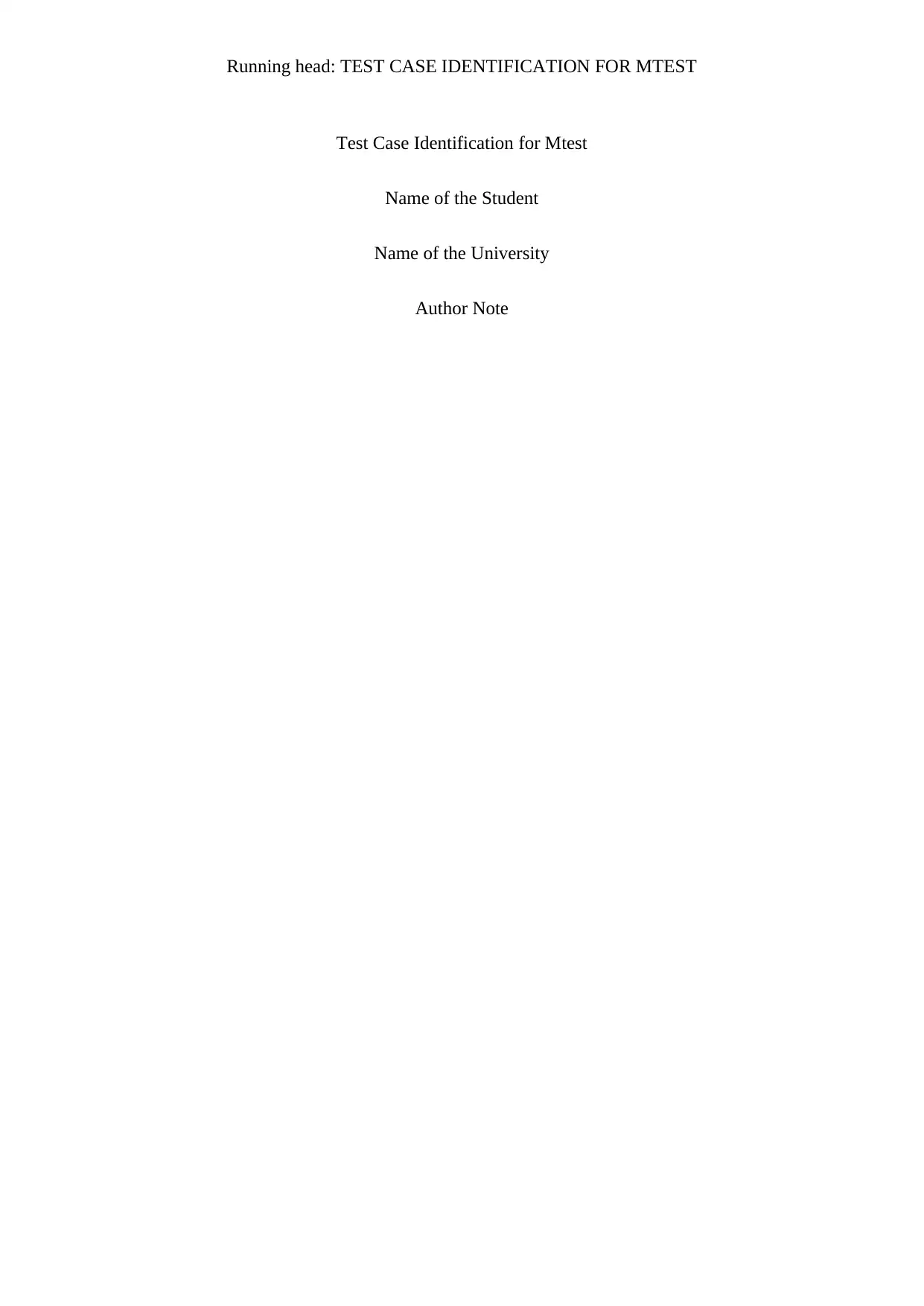
Running head: TEST CASE IDENTIFICATION FOR MTEST
Test Case Identification for Mtest
Name of the Student
Name of the University
Author Note
Test Case Identification for Mtest
Name of the Student
Name of the University
Author Note
Secure Best Marks with AI Grader
Need help grading? Try our AI Grader for instant feedback on your assignments.

1
TEST CASE IDENTIFICATION FOR MTEST
Question 1: Real world example of software failure
Various factors can lead to software failures. These factors can be - upgrading of
applications without ensuring changes regression testing and retesting of the software after
the changes (Harman, Jia & Zhang, 2015). Security of a software also plays an important
role. Applications with vulnerabilities present are easier to exploit (Briand et al, 2016). Bugs
and glitches of software applications lead to inaccurate outcome from the software.
A major security flaw got discovered by an international airline which would allow
anyone having computers with the valid URLs in accessing and manipulating the boarding
passes of passenger flights. The software was a mobile boarding system called TSA. Though
this flaw got timely addressed by the airline and have denied customer data getting
compromised, alarming questions arose from this issue regarding security of data with air
travel becoming more and more dependent on software applications in managing all the
complexities involved.
Here the prompt action of the airline in notifying the vendor helped in resolving the
issues with the fix immediately being released so that the bug cannot get exploited any
further. The fix ensured that the software checked all the several layers of security which
prevents customers from making use of boarding passes that were not theirs’. Since the
duration of the failure was very short, the incident did affect the aviation industry by much.
TEST CASE IDENTIFICATION FOR MTEST
Question 1: Real world example of software failure
Various factors can lead to software failures. These factors can be - upgrading of
applications without ensuring changes regression testing and retesting of the software after
the changes (Harman, Jia & Zhang, 2015). Security of a software also plays an important
role. Applications with vulnerabilities present are easier to exploit (Briand et al, 2016). Bugs
and glitches of software applications lead to inaccurate outcome from the software.
A major security flaw got discovered by an international airline which would allow
anyone having computers with the valid URLs in accessing and manipulating the boarding
passes of passenger flights. The software was a mobile boarding system called TSA. Though
this flaw got timely addressed by the airline and have denied customer data getting
compromised, alarming questions arose from this issue regarding security of data with air
travel becoming more and more dependent on software applications in managing all the
complexities involved.
Here the prompt action of the airline in notifying the vendor helped in resolving the
issues with the fix immediately being released so that the bug cannot get exploited any
further. The fix ensured that the software checked all the several layers of security which
prevents customers from making use of boarding passes that were not theirs’. Since the
duration of the failure was very short, the incident did affect the aviation industry by much.
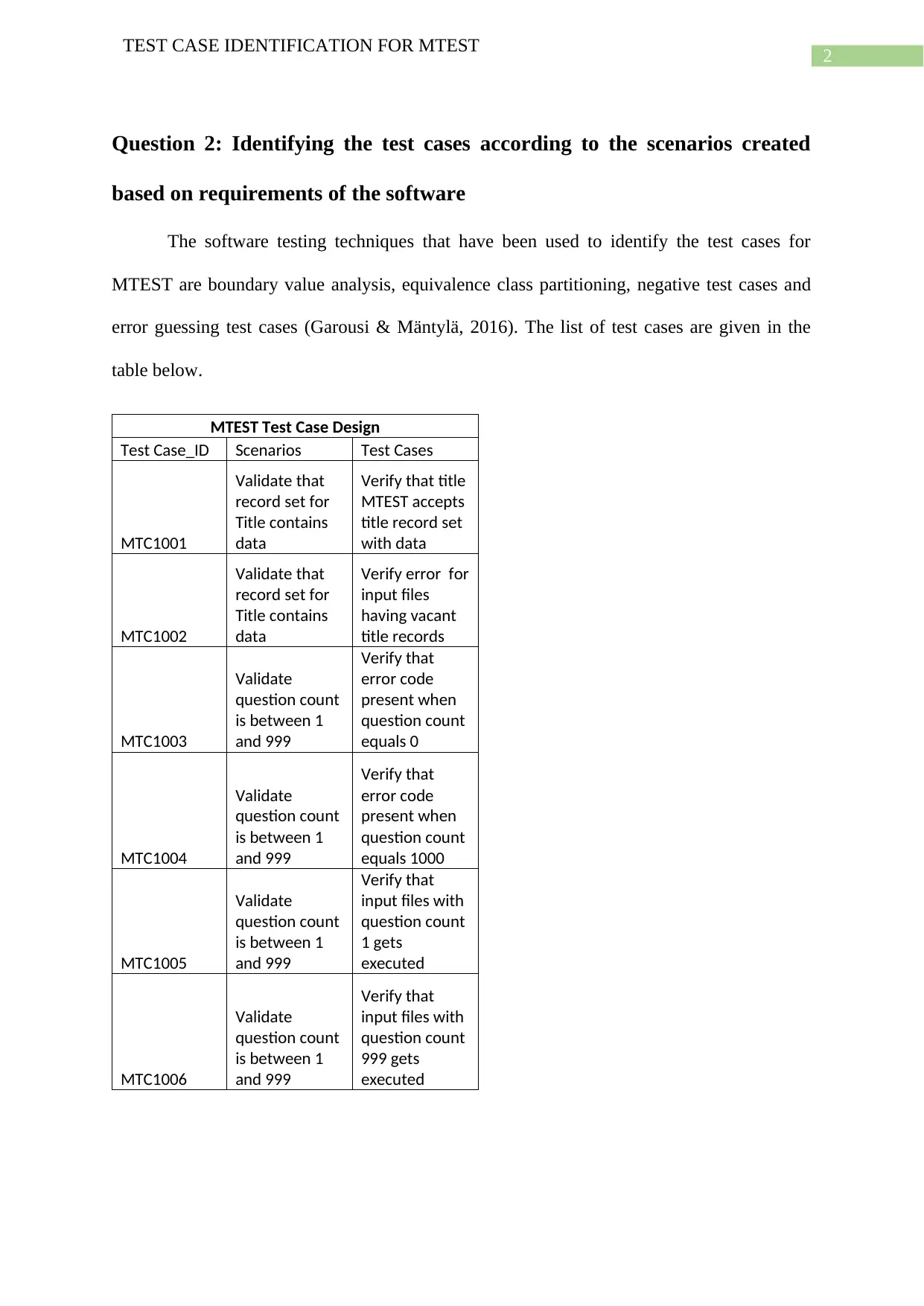
2
TEST CASE IDENTIFICATION FOR MTEST
Question 2: Identifying the test cases according to the scenarios created
based on requirements of the software
The software testing techniques that have been used to identify the test cases for
MTEST are boundary value analysis, equivalence class partitioning, negative test cases and
error guessing test cases (Garousi & Mäntylä, 2016). The list of test cases are given in the
table below.
MTEST Test Case Design
Test Case_ID Scenarios Test Cases
MTC1001
Validate that
record set for
Title contains
data
Verify that title
MTEST accepts
title record set
with data
MTC1002
Validate that
record set for
Title contains
data
Verify error for
input files
having vacant
title records
MTC1003
Validate
question count
is between 1
and 999
Verify that
error code
present when
question count
equals 0
MTC1004
Validate
question count
is between 1
and 999
Verify that
error code
present when
question count
equals 1000
MTC1005
Validate
question count
is between 1
and 999
Verify that
input files with
question count
1 gets
executed
MTC1006
Validate
question count
is between 1
and 999
Verify that
input files with
question count
999 gets
executed
TEST CASE IDENTIFICATION FOR MTEST
Question 2: Identifying the test cases according to the scenarios created
based on requirements of the software
The software testing techniques that have been used to identify the test cases for
MTEST are boundary value analysis, equivalence class partitioning, negative test cases and
error guessing test cases (Garousi & Mäntylä, 2016). The list of test cases are given in the
table below.
MTEST Test Case Design
Test Case_ID Scenarios Test Cases
MTC1001
Validate that
record set for
Title contains
data
Verify that title
MTEST accepts
title record set
with data
MTC1002
Validate that
record set for
Title contains
data
Verify error for
input files
having vacant
title records
MTC1003
Validate
question count
is between 1
and 999
Verify that
error code
present when
question count
equals 0
MTC1004
Validate
question count
is between 1
and 999
Verify that
error code
present when
question count
equals 1000
MTC1005
Validate
question count
is between 1
and 999
Verify that
input files with
question count
1 gets
executed
MTC1006
Validate
question count
is between 1
and 999
Verify that
input files with
question count
999 gets
executed
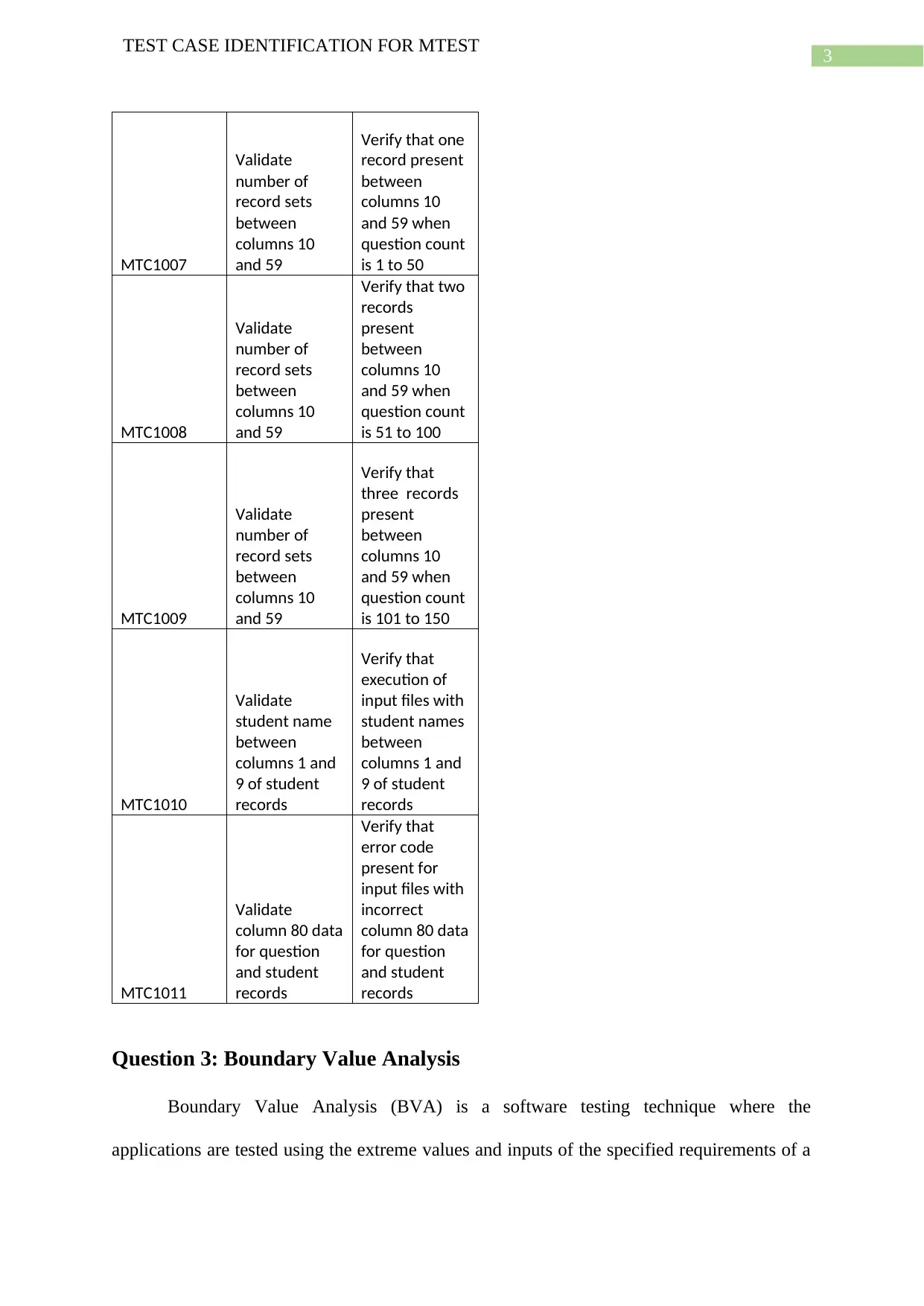
3
TEST CASE IDENTIFICATION FOR MTEST
MTC1007
Validate
number of
record sets
between
columns 10
and 59
Verify that one
record present
between
columns 10
and 59 when
question count
is 1 to 50
MTC1008
Validate
number of
record sets
between
columns 10
and 59
Verify that two
records
present
between
columns 10
and 59 when
question count
is 51 to 100
MTC1009
Validate
number of
record sets
between
columns 10
and 59
Verify that
three records
present
between
columns 10
and 59 when
question count
is 101 to 150
MTC1010
Validate
student name
between
columns 1 and
9 of student
records
Verify that
execution of
input files with
student names
between
columns 1 and
9 of student
records
MTC1011
Validate
column 80 data
for question
and student
records
Verify that
error code
present for
input files with
incorrect
column 80 data
for question
and student
records
Question 3: Boundary Value Analysis
Boundary Value Analysis (BVA) is a software testing technique where the
applications are tested using the extreme values and inputs of the specified requirements of a
TEST CASE IDENTIFICATION FOR MTEST
MTC1007
Validate
number of
record sets
between
columns 10
and 59
Verify that one
record present
between
columns 10
and 59 when
question count
is 1 to 50
MTC1008
Validate
number of
record sets
between
columns 10
and 59
Verify that two
records
present
between
columns 10
and 59 when
question count
is 51 to 100
MTC1009
Validate
number of
record sets
between
columns 10
and 59
Verify that
three records
present
between
columns 10
and 59 when
question count
is 101 to 150
MTC1010
Validate
student name
between
columns 1 and
9 of student
records
Verify that
execution of
input files with
student names
between
columns 1 and
9 of student
records
MTC1011
Validate
column 80 data
for question
and student
records
Verify that
error code
present for
input files with
incorrect
column 80 data
for question
and student
records
Question 3: Boundary Value Analysis
Boundary Value Analysis (BVA) is a software testing technique where the
applications are tested using the extreme values and inputs of the specified requirements of a
Secure Best Marks with AI Grader
Need help grading? Try our AI Grader for instant feedback on your assignments.
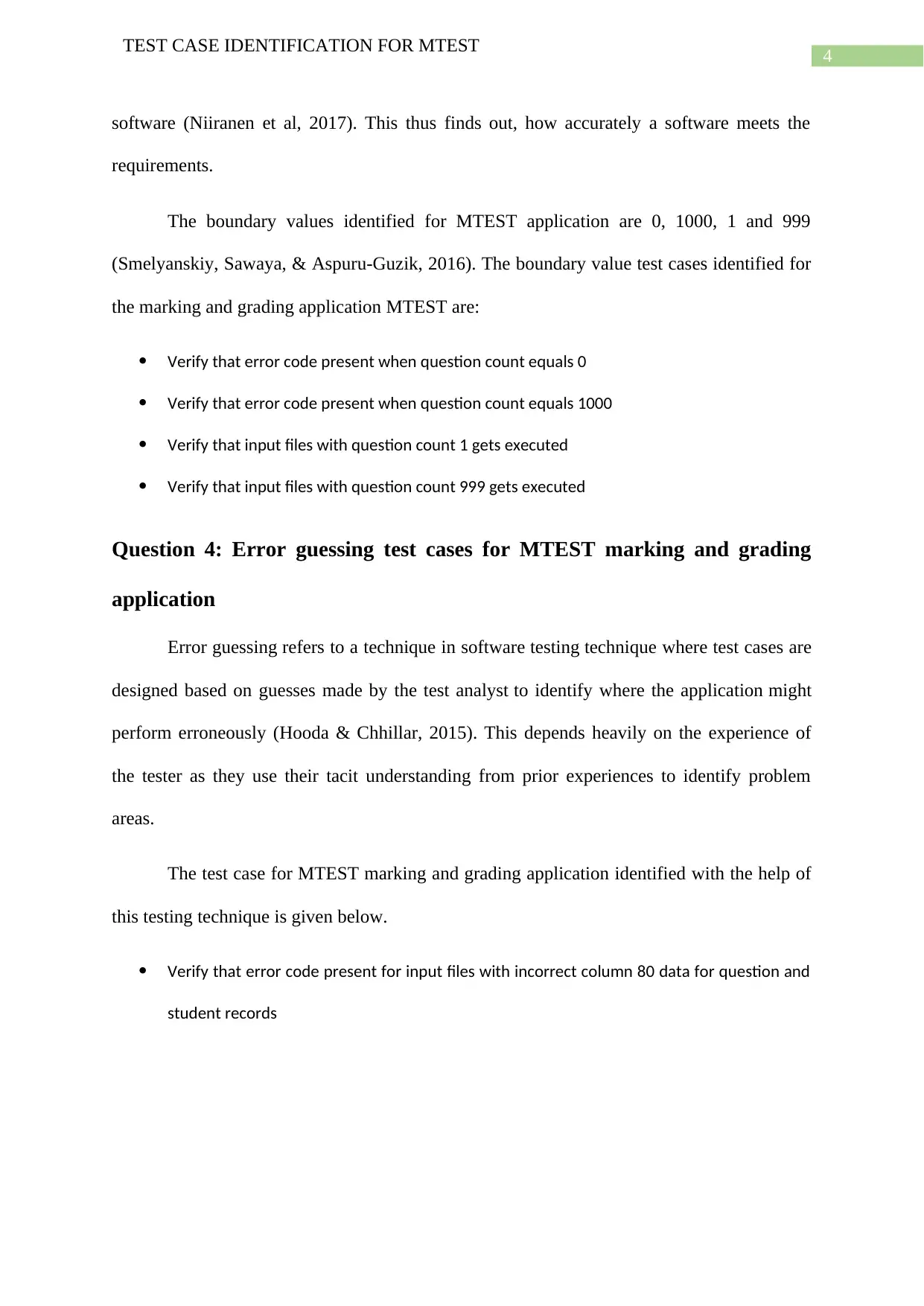
4
TEST CASE IDENTIFICATION FOR MTEST
software (Niiranen et al, 2017). This thus finds out, how accurately a software meets the
requirements.
The boundary values identified for MTEST application are 0, 1000, 1 and 999
(Smelyanskiy, Sawaya, & Aspuru-Guzik, 2016). The boundary value test cases identified for
the marking and grading application MTEST are:
Verify that error code present when question count equals 0
Verify that error code present when question count equals 1000
Verify that input files with question count 1 gets executed
Verify that input files with question count 999 gets executed
Question 4: Error guessing test cases for MTEST marking and grading
application
Error guessing refers to a technique in software testing technique where test cases are
designed based on guesses made by the test analyst to identify where the application might
perform erroneously (Hooda & Chhillar, 2015). This depends heavily on the experience of
the tester as they use their tacit understanding from prior experiences to identify problem
areas.
The test case for MTEST marking and grading application identified with the help of
this testing technique is given below.
Verify that error code present for input files with incorrect column 80 data for question and
student records
TEST CASE IDENTIFICATION FOR MTEST
software (Niiranen et al, 2017). This thus finds out, how accurately a software meets the
requirements.
The boundary values identified for MTEST application are 0, 1000, 1 and 999
(Smelyanskiy, Sawaya, & Aspuru-Guzik, 2016). The boundary value test cases identified for
the marking and grading application MTEST are:
Verify that error code present when question count equals 0
Verify that error code present when question count equals 1000
Verify that input files with question count 1 gets executed
Verify that input files with question count 999 gets executed
Question 4: Error guessing test cases for MTEST marking and grading
application
Error guessing refers to a technique in software testing technique where test cases are
designed based on guesses made by the test analyst to identify where the application might
perform erroneously (Hooda & Chhillar, 2015). This depends heavily on the experience of
the tester as they use their tacit understanding from prior experiences to identify problem
areas.
The test case for MTEST marking and grading application identified with the help of
this testing technique is given below.
Verify that error code present for input files with incorrect column 80 data for question and
student records
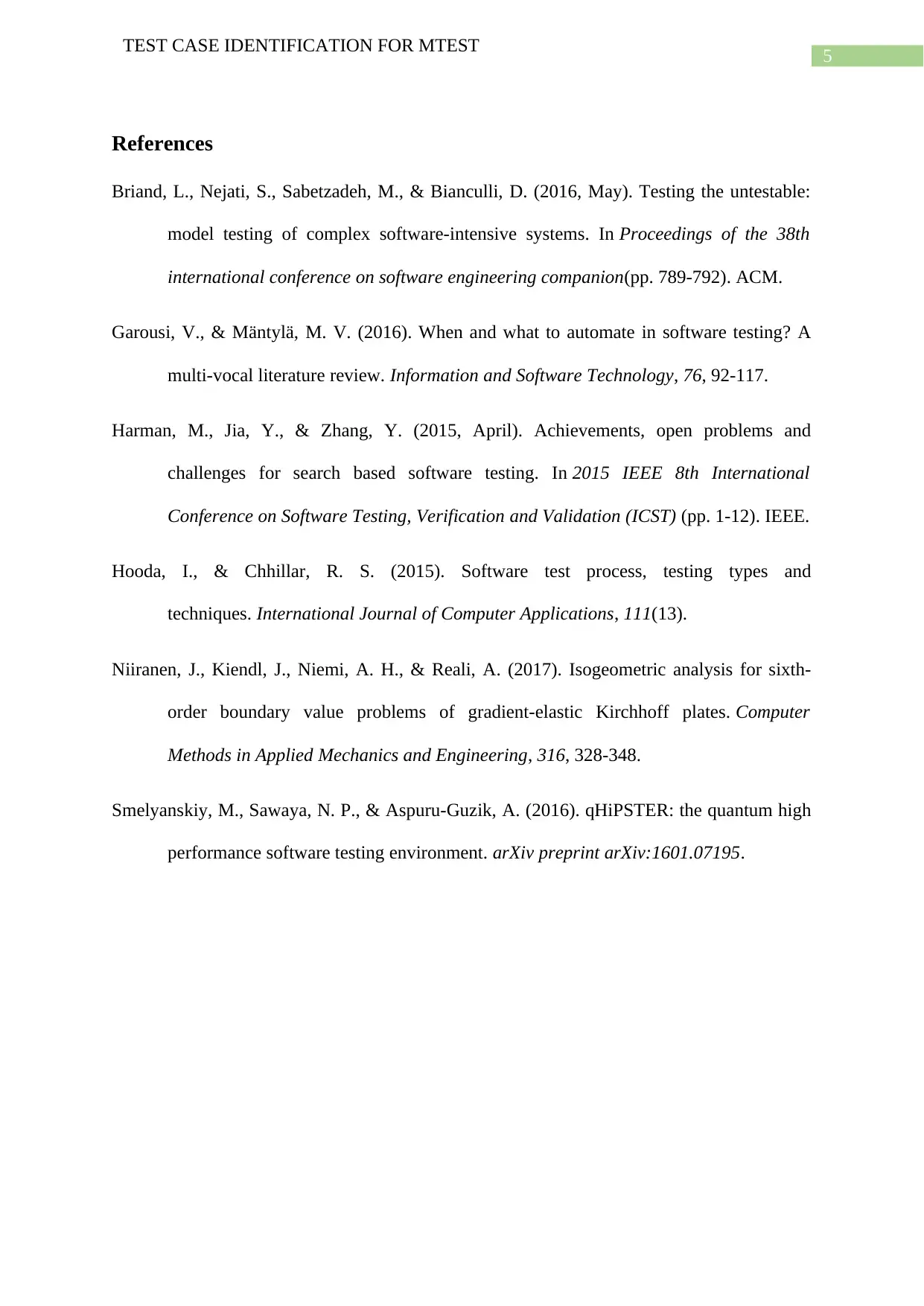
5
TEST CASE IDENTIFICATION FOR MTEST
References
Briand, L., Nejati, S., Sabetzadeh, M., & Bianculli, D. (2016, May). Testing the untestable:
model testing of complex software-intensive systems. In Proceedings of the 38th
international conference on software engineering companion(pp. 789-792). ACM.
Garousi, V., & Mäntylä, M. V. (2016). When and what to automate in software testing? A
multi-vocal literature review. Information and Software Technology, 76, 92-117.
Harman, M., Jia, Y., & Zhang, Y. (2015, April). Achievements, open problems and
challenges for search based software testing. In 2015 IEEE 8th International
Conference on Software Testing, Verification and Validation (ICST) (pp. 1-12). IEEE.
Hooda, I., & Chhillar, R. S. (2015). Software test process, testing types and
techniques. International Journal of Computer Applications, 111(13).
Niiranen, J., Kiendl, J., Niemi, A. H., & Reali, A. (2017). Isogeometric analysis for sixth-
order boundary value problems of gradient-elastic Kirchhoff plates. Computer
Methods in Applied Mechanics and Engineering, 316, 328-348.
Smelyanskiy, M., Sawaya, N. P., & Aspuru-Guzik, A. (2016). qHiPSTER: the quantum high
performance software testing environment. arXiv preprint arXiv:1601.07195.
TEST CASE IDENTIFICATION FOR MTEST
References
Briand, L., Nejati, S., Sabetzadeh, M., & Bianculli, D. (2016, May). Testing the untestable:
model testing of complex software-intensive systems. In Proceedings of the 38th
international conference on software engineering companion(pp. 789-792). ACM.
Garousi, V., & Mäntylä, M. V. (2016). When and what to automate in software testing? A
multi-vocal literature review. Information and Software Technology, 76, 92-117.
Harman, M., Jia, Y., & Zhang, Y. (2015, April). Achievements, open problems and
challenges for search based software testing. In 2015 IEEE 8th International
Conference on Software Testing, Verification and Validation (ICST) (pp. 1-12). IEEE.
Hooda, I., & Chhillar, R. S. (2015). Software test process, testing types and
techniques. International Journal of Computer Applications, 111(13).
Niiranen, J., Kiendl, J., Niemi, A. H., & Reali, A. (2017). Isogeometric analysis for sixth-
order boundary value problems of gradient-elastic Kirchhoff plates. Computer
Methods in Applied Mechanics and Engineering, 316, 328-348.
Smelyanskiy, M., Sawaya, N. P., & Aspuru-Guzik, A. (2016). qHiPSTER: the quantum high
performance software testing environment. arXiv preprint arXiv:1601.07195.
1 out of 6
Related Documents
Your All-in-One AI-Powered Toolkit for Academic Success.
+13062052269
info@desklib.com
Available 24*7 on WhatsApp / Email
![[object Object]](/_next/static/media/star-bottom.7253800d.svg)
Unlock your academic potential
© 2024 | Zucol Services PVT LTD | All rights reserved.




